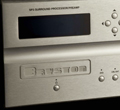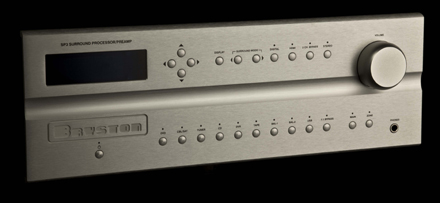UPDATE: Bryston's high-end SP-3 surround processor/preamplifier now available in UK
SP-3 now shipping worldwide, is optimised for stereo use as well as surround, sells for £9995


UPDATE: Bryston's SP-3 surround processor/preamp, announce in November, is now available through UK distributor PMC Loudspeakers. It sells for £9995.
Posted 13.11.2011
New from Canadian company Bryston is the SP-3, a high-end preamp/processor designed for both stereo and the latest surround formats. Designed throughout for sound quality, the SP-3 also has a modular construction to enable future upgrades to be made easily.
Selling for £9995 when it arrives in the UK via distributor PMC, the SP-3 is designed to combine what Bryston describes as 'ultra-high performance, ease of use and legendary build quality'.
It uses Class A discrete circuitry throughout its analogue stages, using premium components and hand-matched transistors throughout rather than the more common integrated circuits, and has separate, isolated power supplies, with toroidal transformers, for the analogue and digital sections, to reduce crosstalk and interference.
Digital to analogue conversion uses a 24-bit delta-sigma chipset from Crystal Semiconductor, and the SP-3's DSP runs on a Texas Instruments engine.
Decoding is provided for Dolby True HD and DTS-HD Master Audio as well as standard Dolby Digital and DTS formats, in 5.1, 6.1 and 7.1 channels, and the SP-3 also has true analogue pass-through for stereo as well as 5.1- and 7.1-channel formats, eliminating all digital processing from the signal path.
Get the What Hi-Fi? Newsletter
The latest hi-fi, home cinema and tech news, reviews, buying advice and deals, direct to your inbox.
There are inputs for 11 sources, including six digital and those stereo and multichannel analogue pass-throughs, and while video from its eight HDMI inputs is switched along with audio, the SP-3 has no onboard video processing, but merely passes the inout video straight to the display.
Again, this is all to do with sound quality, eliminating the need for electrically noisy video processing circuitry.
Multichannel audio outputs are available both standard single-ended and balanced XLRs, and as well as pass-through operation, the SP-3 offers stereo downmixing for all surround modes, digital bass-management and bass redirection modes, Dolby Volume, individual trims and delays for each channel, and set-up memory for each input.
Follow whathifi.com on Twitter
Andrew has written about audio and video products for the past 20+ years, and been a consumer journalist for more than 30 years, starting his career on camera magazines. Andrew has contributed to titles including What Hi-Fi?, Gramophone, Jazzwise and Hi-Fi Critic, Hi-Fi News & Record Review and Hi-Fi Choice. I’ve also written for a number of non-specialist and overseas magazines.
